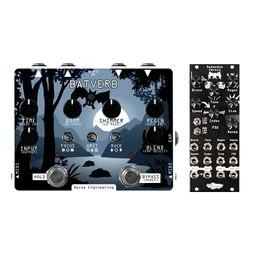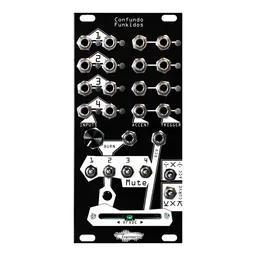Electus Versio: it’s like Desmodus’s cousin, this time with a clock input! Best of all, it’s available for free as an alternate firmware on the Customer Portal, along with all the other Versio firmwares.
Let’s explore what it is, how it’s different from (and similar to) Desmodus, and hear what it can sound like.

The backstory
When we released Desmodus Versio, a few users asked us an interesting question: can you put a clock input on it?
This wasn’t something we had thought about, simply because clocking a reverb isn’t that common.
Our initial challenge in development was that we were limited by hardware memory. Reverbs and delays like Desmodus use lots of memory, and the Desmodus firmware was already using almost all that was available. Plus, in order for the delays to work in a way that makes sense with clocks, we needed longer delay times. Stephen had to do some clever reworking of the delay structure. In the end, we settled on fewer delay lines, but much longer delay times -- this is part of what gives Electus such a unique tone compared to Desmodus.
Once Stephen had gotten over the memory hurdle, the rest of development went pretty smoothly. He sent the rest of the team the firmware to play with, and we all enjoyed it quite a bit: we were surprised by how big a difference there was from Desmodus -- it has attitude.
So, what’s it actually sound like?
What’s different between Desmodus and Electus?
We’ve talked about these two a lot, so what’s the actual differences between them?
First and foremost, the sound: even when it’s not being clocked, Electus can get into much more distorted realms than Desmodus, and Electus has much longer delay times when Dense is turned down.
The FSU button and jack have been replaced by Tap on Electus, acting as tap-tempo/clock input. Electus can also be used without a clock: holding down the Tap button makes Electus generate its own clock, and Size controls the delay times, just like Desmodus.
Speaking of Size: when Electus is being clocked, Size acts as a clock divider/multiplier. To the far left and far right you have 2/1 and 1/2 settings, but the rest are a bit more unusual: 5/8, 7/8… you can find them all in the manual here. They were selected to create interesting and musical rhythms when sharing a clock with a steady sequence.
The other new control is L/C/R: replacing BND/LRP/JMP, L/C/R changes how the delays are structured and panned.

What’s the same between Desmodus and Electus?
In terms of controls: quite a bit!
You still have your standard Blend dry/wet control at the top left. If you want to shape your atmospheres, you have the Tone control -- a DJ-style lowpass/highpass filter in the feedback tank. There’s still a built-in LFO that can modulate the delay lines, controlled by the Speed and Index parameters. Dense still controls how much your atmosphere sounds like a bunch of individual echos or a smeared, reverberant wash.
There are still three modes: LIM when you want something clean, DST when you want something distorted, and SHM when you want some pitch shifting. Those modes don’t sound exactly the same as they did on Desmodus, though: they’re really extreme on the Electus.
And we couldn’t forget Regen: it’s still happy to go well above 100% feedback, and it still ducks based on input signals when you turn it up past 3 o’clock.
LET’S MODULATE
Electus has quite a few CV inputs, so let’s put those to use. Here, we’re modulating quite a few things both by hand and with CV on EV to create some nice warbles and tape-stop effects.
More sounds!
Let’s get into another patch. Electus has pretty long delay times, and they can be clocked synced. Plus, the Regen (feedback) control goes well past 100%, meaning you can create some really unusual atmospheres. The first time I tried out Electus I stumbled upon an atmosphere like this and played with it for quite a long time. Noise Engineering is not responsible for loss of productivity if you spend hours playing around with delays.
Don’t delay, get your delay-verb
If you own a Versio, you can grab Electus (along with all the other firmwares) right now from the Customer Portal 100% free. Need a Versio? Grab one from your favorite retailer or from our webshop!






